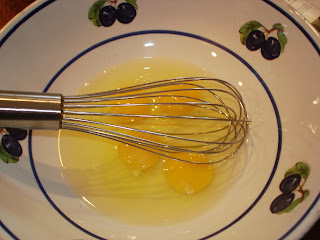Today was a day with absolutely no homework. It was quite odd, actually. I got to go about leisurely, doing whatever I wished the entire afternoon. This of course included cooking a few things. Now for dinner tonight my mom told me that we would probably be having pancakes because there was next to nothing in the house. I couldn't stand for this, knowing we had risotto rice and a recipe I needed to try out. So instead of pancakes we had risotto with red wine.
I was originally just going to make lemon risotto again, thinking we had a lemon. It turned out that we didn't though, as my brother had decided just the day before that he should make, "a tiny bit of fresh lemonade." I'm not quite sure he understood that one lemon doesn't even equal a tiny bit of lemonade. Oh well, I got to try something new. And it was pretty good. There is a whole cup of wine, but the risotto isn't really overpowered. I toasted the rice for a very long time in order for the grains to keep from becoming mush nad I think that helped, as the liquid to rice ratio is higher than in most recipes I have seen.
The other thing I made today was Irish Soda Bread, from Joy of Cooking. While at the Common Ground Fair last weekend I picked up some honey that tastes divine and really needed bread that I could eat with it. This bread is very good, like a lightly sweetened giant scone with tons of raisins. It would be different had I added the caraway seeds, but my mom absolutely loathes caraway, anise and all of those licorice like flavors. Thus, no caraway, but I could tell as I ate it that it would be a good addition. It is a very quick bread to make as it has no yeast and no need for rising. I would suggest that you keep the sugar at 2 tablespoons, as the raisins make it sweet enough.
The last thing I need to mention is how my mom's birthday is coming up, which means I am able to make a cake. I would just like to say that I am planning two cakes, one for Saturday night and one for Sunday afternoon, both of which I will post. The Sunday afternoon one is much more grand and spectactular than the Saturday night one, even though it it one of Julia Child's. On Suday I plan to make the Biscuit Joconde Emprime-Entremet from the January Daring Bakers Challenge. It is, in essence, a sponge cake wrapped around a variety of fillings, such as mousses, curds, cheesecakes, meringue, ect. It stands entirely on its own like a trifle outside of a bowl. Needless to say, this will be an experience.
Smitten Kitchen Adapted this from Mario Batali
Yield: 6 to 8 first-course servings.
1/4 cup extra virgin olive oil
1 medium onion, finely diced
1 1/2 cups arborio rice
1 cup Barolo or other dry red wine
6 cups chicken stock, preferably homemade, or low-sodium, canned
3 tablespoons cold, unsalted butter, cut into small pieces
1/3 cup freshly grated Parmesan cheese, more for serving.
1. In a wide, deep skillet, heat oil until very hot but not smoking. Add onion and cook, stirring, until softened and translucent, 8 to 10 minutes. Do not brown; reduce heat as needed. Add rice and stir with a wooden spoon until opaque and slightly toasted.
2. Meanwhile, heat the stock in a saucepan and keep it just below a simmer. Add wine and a ladleful of hot stock and cook, stirring often, until liquid is absorbed. Continue stirring and adding hot stock a ladleful at a time, always waiting until liquid is almost completely absorbed before adding more. Cook until rice is tender and creamy but not mushy, about 20 minutes. Toward the end of cooking time, rice will quickly soften, so stir constantly and taste often. Turn off heat and stir in butter. Stir in cheese and serve with additional Parmesan.
Irish Soda Bread
Joy of Cooking 75th Anniversary Addition
One 8-Inch Round Loaf or 8 1/2 by 4 1/2-inch loaf
When the batter is made with the greater amount of sugar and buttermilk and baked in a loaf pan, it becomes a fine crusty bread that stays moist for 3 to 4 days.
Preheat the oven to 375 degrees Farenheit, 350 if you are baking in a loaf pan. Grease a large baking sheet or an 8 1/2 by 4 1/2-inch loaf pan.
Whisk together thoroughly in a large bowl:
1 2/3 cup all-purpose flour
2 tablespoons sugar, or 5 tablespoons for the tea loaf
1 teaspoon baking powder
1/2 teaspoon baking soda
1/2 teaspoon salt
Stir in:
1 cup raisins
(2 teaspoons caraway seeds)
Whisk together in another bowl:
1 large egg
2/3 cup butter milk (or 2 teaspoons vinegar and 2/3 cup milk), or 1 cup for the tea loaf
1/4 cup ( 1/2 stick) butter, melted and still warm
Add to the flour mixture and stir until just the ingredients are moistened. The batter will be stiff but sticky. Scrape the batter onto the baking sheet in a mound 6 to 7 inches in diameter, or scrape it into the loaf pan and spread evenly. Use a sharp knife to slash a large X about 1/2 inch deep on top of batter.
Bake until golden brown and a toothpick inserted in the center comes out clean, 25 to 30 minutes on the baking sheet, 45 to 50 minutes in the loaf pan. Transfer the round loaf to a rack to cool completely before serving. Or, if using a loaf pan, let cool in the pan on a rack for 5 to 10 minutes before unmolding to cool completely on the rack.

















































